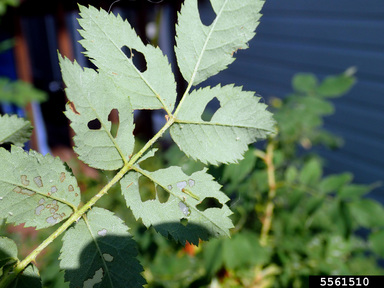Happy National Rose Month! Roses have a long and colorful history. They have symbolized love, beauty, war, and politics throughout centuries. The Rose itself has been dated back to 35 million years old and its current family tree contains 125 different species of roses occurring naturally throughout the Northern Hemisphere. Despite all this, they often are targeted by diseases and pests. However, through proper care, cultivar selection, and placement, you can avoid a lot of rose diseases.
Placement: It’s important to remember to place roses in an area where they will receive lots of sun and that has good airflow.
Cultivar Selection: Certain cultivars of roses are more or less susceptible to certain diseases and pests. In fact, Knock Out roses became popular in the late 1990s because they are highly resistant to many common rose diseases.
TLC: They also prefer regular pruning to remove dead tissue and reduce density that could inhibit airflow.
However, even if you take exceptional care of your roses it’s possible they will still develop a disease or pest issue. To help you identify issues and prevent damage to your roses, we’ve compiled a list of the most common rose diseases/pests in our area and their symptoms so you can know what to look out for.
1. Black Spot
Blackspot also known as leaf spot and leaf blotch is a dangerous fungal disease for roses. This fungal disease is spread through splashing water and tends to infect trees during rainy periods. If left untreated, rose bushes will become defoliated, weak, and susceptible to other diseases.
Symptoms:
- Circular black spots on the upper surface of leaves
- Yellow Leaves
- Defoliation
Susceptible cultivars & varieties include most yellow and copper-colored roses and most hybrid teas.
Resistant cultivars & varieties include ‘Coronado’, ‘Simplicity’, ‘Grand Opera’, ‘Carefree Beauty’, ‘Bonica’, ‘Carefree Celebration’, ‘Carefree Spirit’, ‘Noamel’, ‘Fire Meidiland’, ‘White Out’, ‘Knock Out’, and ‘Fortyniner’.

2. Powdery Mildew
Powdery Mildew is a tree fungus that produces a white powder along the top and bottoms of the leaves and along the stem. Left untreated the overall health of the rose bush will suffer with its leaves eventually dying and falling off.
Symptoms:
- Spots/patches of white to grayish, talcum-powder-like growth on the upper side of leaves.
- Leaves with a wrinkled appearance
Susceptible cultivars & varieties include most rose climbers, small-flowered ramblers, some floribundas, grandifloras, and hybrid teas.
Resistant cultivars & varieties include ‘Blanc Double de Coubert,’ ‘Fru Dagmar Hastrup’ (‘Frau Dagmar Hartopp’) ‘Rugosa Alba,’ ‘Topaz Jewel’, and ‘Alba Semi-Plena’

3. Rose Rust
Rose rust is a common fungal disease that affects roses. Not nearly as damaging as Black Spot and Powdery mildew, this fungus infects roses in the spring during periods of moist, cool weather and persists through fall.
Symptoms:
- small orange or rust-colored spots on leaves
- distorted young green stems in spring
- early leaf drop
- yellow/brown leaves
Resistant cultivars & varieties include Albas, Bourbons, Centifolias, Damasks, Gallicas, Noisettes, Rugosas.

4. Aphids
Aphids, also known as plant lice, will likely be found on new shoots and buds. These plant-sucking insects feed on the sap of roses. Their excrement, referred to as honeydew, is commonly mistaken for sap. Aphids are most active in spring and summer. If not treated large infestations can slow the growth of the plant, ruin buds, and deform emerging leaves.
Symptoms:
- Drooping Leaves
- Yellow Spots
- Black small dots on the underside of the leaves (these are what aphids look like to the naked eye)
- Honeydew
- Sooty Mold

5. Spider Mites
Spider mites are a common enemy of anyone who cares about their roses. Classified as arachnids, these tiny tree bugs are less than 1/20 inch long when fully mature and look like moving dots to the naked eye. Their ability to rapidly reproduce allows large populations to develop fast and severely harm your roses before you even realize you have a problem. Learn more about Spider Mites.
Symptoms:
- Stippling of light dots on leaves/needles
- Leaves turning yellow or reddish
- Leaves dropping off
- Webbing covering leaves
- Tiny moving dots on the underside of leaves (what these mites look like to the naked eye)

6. Rose Sawfly
Rose sawfly, also referred to as rose slug, is a common pest of roses. Early feeding will leave transparent sections of leaf tissue but as the larvae grow they will being to fully eat through the leaf creating holes. Larvae can usually be found on leaves in May and June; however, rose sawflies are active through fall.
Symptoms:
- transparent sections of leaf tissue
- elongated holes in leaves
- skeletonization of leaves


7. Japanese Beetles
Japanese Beetles are most prevalent from June through August and can defoliate a rose bush in a matter of days. These beetles are skeletonizers, which means they feed on leaf tissue leaving only the veins behind and in heavy infestations the entire tree can be affected, tuning all leaves brown. These beetles tend to congregate in large numbers on rose flowers, chewing holes in flower buds, petals, and foliage.
Symptoms:
- Large amounts of brown chewed leaves.
- Holes in leaves
- Skeletonized leaves (only the veins of the leaf left intact)
- Leaves falling off

Are your roses experiencing symptoms of the above diseases and pests? We can help! Give us a call at 703.573.3029 or book an appointment through our online booking system to meet with one of our Certified Arborists. Our Arborists will be able to inspect your roses, diagnose them, and create a treatment plan to solve their issues.


